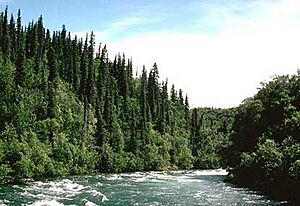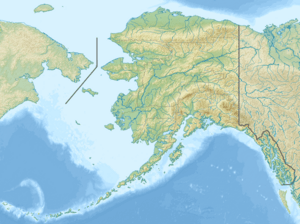Alagnak River facts for kids
Quick facts for kids Alagnak River |
|
|---|---|

Rapids on the Alagnak
|
|
|
Location of the mouth of the Alagnak River in Alaska
|
|
| Country | United States |
| State | Alaska |
| Borough | Lake and Peninsula |
| Physical characteristics | |
| Main source | Kukaklek Lake Katmai National Park and Preserve 811 ft (247 m) 59°07′53″N 155°32′39″W / 59.13139°N 155.54417°W |
| River mouth | Kvichak River 58 miles (93 km) east of Dillingham, Alaska Peninsula 0 ft (0 m) 59°00′17″N 156°51′37″W / 59.00472°N 156.86028°W |
| Length | 64 mi (103 km) |
| Type: | Wild |
| Designated: | December 2, 1980 |
The Alagnak River is a 64-mile (103 km) river in Alaska, a state in the United States. It flows into the Kvichak River. The Alagnak River is special because it is part of the National Wild and Scenic Rivers System. This means it is protected for its natural beauty and wildlife.
The river's water collects from an area of about 1,400 square miles (3,600 km2). You can find it in the middle of the Lake and Peninsula Borough.
Contents
What's in a Name?
The name Alagnak has a couple of interesting possible meanings.
Meaning "Making Mistakes"
The National Park Service says that in the local language, Alagnak means "making mistakes". This is because the river changes its path often. It can split into new branches, making it easy for boaters to get lost. Locals sometimes call it the "Branch River" for this reason.
Meaning "Red Berry"
Another idea is that the name comes from the Yupik word alagnaq. This word refers to a type of red berry. The United States Geological Survey agrees with this idea. They say that a language expert named Richard H. Geoghegan believed the native word meant "wild raspberry".
River's Journey
The Alagnak River starts from Kukaklek Lake. This lake is located in Katmai National Park and Preserve.
Starting Point and Upper River
The river begins in the Aleutian Range, a mountain chain. For the first six miles, the river flows slowly through flat, treeless land called tundra. Along this upper part, you'll mostly see spruce trees.
Middle and Lower River
After the tundra, the river valley becomes much narrower. It has steep rock walls. Miles 7 to 14 flow through a tight canyon at about 7.5 miles per hour. The Nonvianuk River joins the Alagnak around mile 20. The Alagnak then winds its way across the Alaska Peninsula. Finally, it flows into the Kvichak River, which then empties into Bristol Bay.
Animals and Plants
The Alagnak River is home to many different animals and plants. It's a great place to see Alaskan wildlife.
Fish and Bears
Many salmon swim in the river, especially in summer and fall. This attracts a lot of bears, including both grizzly and black bears. Besides salmon, you can also find rainbow trout, char, Arctic grayling, and northern pike in the water.
Other Mammals
The area around the river is a winter home for Alaskan caribou. Moose live here all year round. You might also spot beavers, foxes, wolverines, mink, otters, and sometimes even wolfes.
Plants Along the River
The plants along the river are varied. You'll see spruces, willows, and many kinds of berries.
River's Past
The Alagnak River has a long and interesting history, with people living near it for thousands of years.
Early Human History
People first arrived in the Alagnak area about 14,000 years ago. This was after the last ice age ended. The oldest proof of people living here is from 9,000 years ago. Stone tools from that time have been found near old camps. About 7,000 years ago, natives used special tools called atlatl to hunt caribou.
The first villages where people lived all year were built about 2,300 years ago. These villages grew quickly to deal with changes in the weather. Pottery from 2,500 years ago has also been found.
Arrival of Europeans and Canneries
The first Europeans came to the area in the 1800s. A Russian captain named Tebenkov wrote about the river in 1852. Around 1860, native people started leaving the Alagnak River village.
In 1900, the North Alaska Salmon Company built two canneries. These were factories that processed salmon. One was called Lockanok, and the other was Hallerville. They were connected by a small railroad. Many people came to work at these canneries because there was so much salmon. This allowed them to buy new things like coffee and sugar.
Changes and Challenges
In 1916, Libby, McNeill & Libby bought the canneries. By the 1920s, it became harder to can salmon because the riverbanks were eroding. The cannery closed in 1936 and burned down in 1937. People used the leftover wood to build new homes.
Around 1918-1919, a widespread sickness affected the villages. Despite this, villages along the river did well because of jobs at the cannery. After the sickness, more white settlers moved to the Alagnak area.
Growing Popularity
In 1927, the first airplane landed near the canneries. This made it easier to reach the area. Soon, hunting and fishing became popular. From 1937, people started flying in for hunting trips. The river's great fishing was even featured in Field and Stream magazine in 1941.
Jay Hammond, who later became the governor of Alaska, was a well-known fishing guide here. He first flew to the river in 1946. From 1938 to 1947, people also came to look for gold and trap beavers. Beaver fur was very valuable then. Hunting for large animals like the Alaska Peninsula brown bear also became popular. Hunting and fishing lodges were built around 1957.
Becoming a Protected Area
When Katmai National Park and Preserve was created nearby in 1921, people started thinking about protecting the Alagnak River too. Hunters and fishermen were worried this would stop them from their activities.
In 1980, the Alaska National Interest Lands Conservation Act made the Alagnak a "Wild River". This law protected the wilderness but still allowed some hunting, trapping, and fishing. Many hunters come to the Alagnak for moose and grizzly bears.
Wild River Designation
In 1980, about 67 miles (108 km) of the upper Alagnak River and one of its branches, the Nonvianuk River, were named "wild". This is part of the National Wild and Scenic Rivers System. The Nonvianuk River is about 11 miles (18 km) long.
Visiting the Alagnak
The Alagnak River is a very important place for sport fishing in Alaska. Many people come here to fish.
Boating and Rafting
The river is easy to navigate for people in canoes. Some parts of the river have rapids, from easy (level 1) to more challenging (level 3). These rapids can be dangerous for people who are not experienced, especially when the water is high. It is possible to carry boats around the rapids, but it can be difficult.
See also
 In Spanish: Río Salvaje Alagnak para niños
In Spanish: Río Salvaje Alagnak para niños


